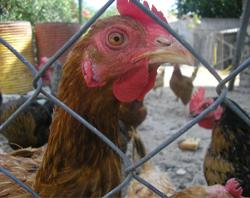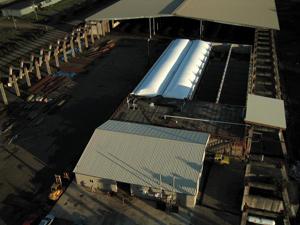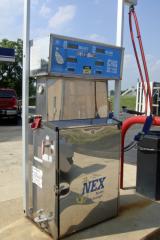Frequent Questions about Livestock Biogas Projects
Frequent questions are grouped by topic. Click on a question to view the answer.

- What is anaerobic digestion?
Anaerobic digestion is a process through which bacteria break down organic matter—such as manure—without oxygen. As the bacteria “work,” they generate biogas. The biogas that is generated is made mostly of methane, the primary component of natural gas.
- Are farmers using anaerobic digesters in the United States?

Yes! Anaerobic digesters work best at farms that collect large amounts of manure as a liquid or slurry on a daily basis. AgSTAR estimates that biogas recovery systems are technically feasible at over 8,000 large dairy and hog operations alone. Use of anaerobic digestion at poultry and beef operations is also growing as new technologies enter the market. Although projects at poultry and beef farms are technically feasible, their economic feasibility can vary.
Today there are 248 anaerobic digesters operating at livestock farms in the United States. Learn more about these projects:
- How does an anaerobic digester work?
An anaerobic digester is a closed system that harnesses the natural process of anaerobic digestion to produce biogas and other useful coproducts.
- Are anaerobic digester projects financially viable?
Yes! However, one of the biggest obstacles to the widespread adoption of on-farm anaerobic digestion has been cost. To help pay for up-front capital costs, anaerobic digester operators may use several funding sources, including grants, cash reimbursements, loan guarantees, industrial bonds, private funding and other cost-sharing agreements.
In addition, up-front capital costs may be offset by revenue generated from the system’s operation. These include the sale of electricity, fuel and other coproducts—like soil amendments, compost and fertilizer—that are generated by the system.
- Are there safety concerns with the use of anaerobic digesters?
There are more than 200 anaerobic digesters safely operating at farms across the United States. Workers at these facilities take proper precautions handling and storing organic material and managing production of electricity and combustible gases. If improperly handled, the gases produced from anaerobically digesting manure may be hazardous, potentially causing fire, explosion or asphyxiation. However, these risks can be safely and adequately mitigated, and should not deter development of new anaerobic digesters.

- What are the benefits of anaerobic digesters?
- Can biogas be piped or transported for sale?
Yes. Biogas can be processed to remove impurities and sold. When processed and compressed, biogas can be piped—just like natural gas.
- How do you calculate carbon credits for methane emission reductions?
Carbon credits are calculated based on the amount of methane reduced through the installation of an anaerobic digester. This approach considers:
- how much methane was emitted before the digester was installed—or “baseline” emissions
- how much methane is emitted after the digester is installed
Baseline emissions have a major influence on the carbon credit that can be claimed, and can vary a great deal for farm-based anaerobic digesters, based on how the manure was originally managed. For example, storage lagoons emit much more methane than manure stacks. If a farm originally managed its manure using storage lagoons, its anaerobic digester carbon credit would likely be larger than a farm generating the same amount of biogas that originally managed its manure using manure stacks.
- How can my project apply for a RIN (Renewable Identification Number)?
Anaerobic digesters may be eligible to generate Renewable Identification Numbers (RINs) under the Renewable Fuel Standard (RFS) if the biogas is processed into a transportation fuel and used in the transportation sector.
- Renewable Fuels: Compliance Help provides more information about the RFS, how to register an approved biogas pathway to generate RINs, and how to petition for a new biogas pathway to generate RINs.

- Do all projects have to be on farms?
 Photo Credit: RCM International LLC
Photo Credit: RCM International LLCNo. While the majority of operating projects in the United States are located on farms, projects can be located off-site. Projects that rely on feedstocks from multiple sources (e.g., codigestion) or locations may be centrally located to minimize transportation cost of the feedstocks.
Please note that different feedstocks can result in different volumes and compositions of the coproducts created by the system. For example, food processing waste may contain excess nutrients like nitrogen. As a result, anaerobic digesters that use multiple feedstocks may be subject to different permitting or regulatory requirements. Also, some incentives and net metering laws may also require a portion of the digester feedstock to come from manure.
- AgSTAR’s Guidelines and Permitting page provides information on state and federal requirements for anaerobic digestion and codigestion
- How do I know if it makes sense for my farm?
To determine if an anaerobic digester is right for your farm, you need to consider: how manure is handled at your facility, the frequency of manure collection, the options available for using the recovered biogas, applicable guidelines and your potential return on investment.
- Can this work on small farms?
Yes. The majority of anaerobic digesters in the United States are on larger farms, but there are options for smaller facilities. One of the primary factors is whether manure can be collected as a liquid, slurry or semi-solid, frequently, at a single location. Anaerobic digesters can be worth the investment at a small farm depending on the rate obtained for the sale of electricity back to the local utility, from carbon credits, or from potential sales of system-related coproducts (e.g., composts and fertilizers). Thermal applications for the biogas may be an excellent option in place of electricity generation. Also, smaller farms may benefits from codigestion of other feedstocks to boost biogas production and increase the financial viability of the project.
The Minnesota Project Exit, which provides information on digester opportunities for mid-sized farms, is a good resource for small farms interested in anaerobic digestion.
- Can I codigest manure with other organic waste?
Many digester projects are incorporating other feedstocks to increase biogas production. However, there are a variety of factors that affect feasibility.
- AgSTAR’s Project Planning page provides information to evaluate the feasibility of anaerobic digestion projects, including those using codigestion
- What do I need to know about permitting?
Anaerobic digestion and codigestion systems may be subject to federal and/or state air, solid waste, and water permitting requirements. In addition, local permits could be required for construction, zoning, and stormwater management. Always check with your local and state regulatory agencies to determine the permits required for your project.
- AgSTAR’s Guidelines and Permitting page provides information on state and federal requirements for anaerobic digestion and codigestion
- How are potential hazards addressed in the design and operation of an anaerobic digester?
There are many ways to reduce risk at an anaerobic digester. These include both common-sense measures to prevent accidents and specific design measures to manage exposure to confined biogas. As with any energy system, it is important to design and maintain the system properly. Also, always follow basic safety precautions and good work practices to reduce potential risk.
For example, to avoid the threat of fire or explosion, there should never be open flames near the digester. All equipment used around the digester should be non-sparking and explosion proof.
To avoid the threat of asphyxiation, the system should be designed so that it is not necessary to enter the confined manure storage space in order to maintain it. If it is necessary to enter the confined space, workers should wear protective equipment, including a self-contained breathing apparatus.
There are several resources that further address safety concerns. AgSTAR produced a comprehensive manual on safety practices in December, 2011 that remains relevant. Cornell University produced a guide for conducting a safety walk-through on a farmExit and Penn State Extension offers educational resources on manure pit safetyExit.
- Is it safe to live near an anaerobic digester?
Yes. Anaerobic digesters provide many benefits and can decrease some of the risks associated with manure spills near a farm. Benefits include reduced odor, diminished potential for nitrogen and phosphorus run-off and decreased pathogen levels in the digestate. In fact, digesters can destroy more than 90 percent of disease-causing bacteria in manure, which reduces the risk to human health in the event of a spill or leak.
Additionally, there are federal regulations and state permitting requirements for anaerobic digesters. These measures are designed to protect the health and safety of the farmers and the public at large.

- Who can I contact to learn more about anaerobic digestion projects?
- AgSTAR can help you learn more about EPA’s agricultural methane emission reduction program
- AgSTAR Partners -- including state and non-governmental organizations – can help you learn about permitting requirements, incentives and emerging research
- AgSTAR's Stories from the Farm provide insights from operating anaerobic digesters
- International activities highlight progress in deploying anaerobic digestion technology all around the world
- The Vendor Directory connects you with anaerobic digester designers, project developers, energy service providers, equipment manufacturers and distributors, and commodity organizations
- USDA and DOE provide resources and information to support anaerobic digester projects



